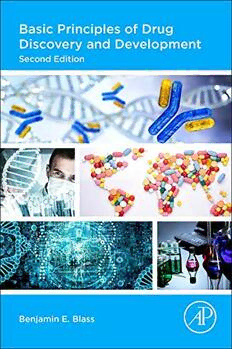
Basic Principles of Drug Discovery and Development PDF
Preview Basic Principles of Drug Discovery and Development
BASIC PRINCIPLES OF DRUG DISCOVERY AND DEVELOPMENT BASIC PRINCIPLES OF DRUG DISCOVERY AND DEVELOPMENT SECOND EDITION B E. B ENJAMIN LASS TempleUniversitySchoolofPharmacy,DepartmentofPharmaceuticalSciences, MoulderCenterforDrugDiscoveryResearch,Philadelphia,PA,UnitedStates AcademicPressisanimprintofElsevier 125LondonWall,LondonEC2Y5AS,UnitedKingdom 525BStreet,Suite1650,SanDiego,CA92101,UnitedStates 50HampshireStreet,5thFloor,Cambridge,MA02139,UnitedStates TheBoulevard,LangfordLane,Kidlington,OxfordOX51GB,UnitedKingdom Copyright©2021ElsevierInc.Allrightsreserved. Nopartofthispublicationmaybereproducedortransmittedinanyformorbyanymeans, electronicormechanical,includingphotocopying,recording,oranyinformationstorageand retrievalsystem,withoutpermissioninwritingfromthepublisher.Detailsonhowtoseek permission,furtherinformationaboutthePublisher’spermissionspoliciesandourarrangements withorganizationssuchastheCopyrightClearanceCenterandtheCopyrightLicensingAgency, canbefoundatourwebsite:www.elsevier.com/permissions. Thisbookandtheindividualcontributionscontainedinitareprotectedundercopyrightbythe Publisher(otherthanasmaybenotedherein). Notices Knowledgeandbestpracticeinthisfieldareconstantlychanging.Asnewresearchandexperience broadenourunderstanding,changesinresearchmethods,professionalpractices,ormedical treatmentmaybecomenecessary. Practitionersandresearchersmustalwaysrelyontheirownexperienceandknowledgein evaluatingandusinganyinformation,methods,compounds,orexperimentsdescribedherein.In usingsuchinformationormethodstheyshouldbemindfuloftheirownsafetyandthesafetyof others,includingpartiesforwhomtheyhaveaprofessionalresponsibility. Tothefullestextentofthelaw,neitherthePublishernortheauthors,contributors,oreditors, assumeanyliabilityforanyinjuryand/ordamagetopersonsorpropertyasamatterofproducts liability,negligenceorotherwise,orfromanyuseoroperationofanymethods,products, instructions,orideascontainedinthematerialherein. BritishLibraryCataloguing-in-PublicationData AcataloguerecordforthisbookisavailablefromtheBritishLibrary LibraryofCongressCataloging-in-PublicationData AcatalogrecordforthisbookisavailablefromtheLibraryofCongress ISBN:978-0-12-817214-8 ForInformationonallAcademicPresspublications visitourwebsiteathttps://www.elsevier.com/books-and-journals Publisher:SusanDennis AcquisitionsEditor:EmilyMcCloskey EditorialProjectManager:LindsayLawrence ProductionProjectManager:PaulPrasadChandramohan CoverDesigner:MarkRogers TypesetbyMPSLimited,Chennai,India Dedication Sir Isaac Newton, one of the greatest scientists of his time, wrote “If I have seen further it is by standing on the shoulders of Giants.” Although he was almost certainly referring to his scientific achieve- ments, the underling concept of learning from our forbearer is true in any endeavor. Indeed, this concept can be further extended to include those who are there in the present day, supporting the activities of an individual as he or she attempts to accomplish that which they view as important. With this thought in mind, I have dedicated this book to the scientists who came before me, those who mentored me, and those who work with me on a daily basis. In addition, and perhaps more impor- tantly, this text is dedicated to the loving and supportive family that has helped me become the person that I am today. Special thanks are offered to my mother, father, sister, brother, my three children, and of course, my wife Kathleen. These are the giants on whose shoulders I have stood upon. Contents Foreword xv 1. Drug discovery and development: An overview of modern methods and principles 1 Drugdiscoveryanddevelopmentfrom20,000Feet 11 Targetselection:thefirststepforward 15 Hitidentification:findingastartingpoint 19 Identifyaclinicalcandidate:jugglingtheproperties 25 Questions 31 References 31 2. The drug discovery process: From ancient times to the present day 43 Theageofbotanicals:pre-industrialdrugdiscovery 44 Earlybiotherapeutics:beforethebiotechnologyrevolution 48 PaulEhrlich:thefatherofmoderndrugdiscovery 51 Milestonesindrugdiscovery 53 Milestonesinanimalmodels:breedingabettermodel 54 TheWistarrat 54 Immunocompromisedmice 55 Transgenicanimalmodels 56 Knockoutanimalmodels 58 Milestonesinmolecularscience 60 X-raycrystallography 60 Molecularmodelingandcomputationalchemistry 63 High-throughputtechnology:chemicalsynthesisandscreeningscience 64 Milestonesinbiotechnology 70 RecombinantDNAandtransfectiontechnology 72 Polymerasechainreactiontechnology 75 DNASequencingandgenomics 76 Proteomics 80 Monoclonalantibodyandhybridomatechnology 83 Theriseofbiologicsandmacromoleculartherapeutics 86 Societalandgovernmentalimpacts 87 ThePureFoodandDrugActof1906 88 TheElixirofSulfanilamideDisasterof1937 89 TheThalidomidestory 91 Regulatorymilestones 93 vii viii CONTENTS Durham-HumphreyAmendmentof1951 94 Kefauver-HarrisAmendmentof1962 95 Hatch-WaxmanActof1984 96 BiologicsPriceCompetitionandInnovationActof2009 97 Futuredevelopmentsindrugdiscovery 99 Questions 99 References 100 3. Classical targets in drug discovery 111 Proteinstructure 113 Enzymes 119 Inhibitionofenzymes 125 G-protein-coupledreceptors 130 G-protein-dependentsignalingpathways 133 Cyclicadenosinemonophosphatesignaling 134 IP signaling 136 3 β-Arrestinpathways 138 G-protein-coupledreceptorsignalingpathways 140 ModulatingG-protein-coupledreceptorsignaling 141 Ionchannels 143 Gatingmechanisms 149 Ligand-gatedchannels 149 Voltage-gatedchannels 152 Othergatingmechanisms 155 Membranetransportproteins(transporters) 156 Nuclearreceptors 164 Nuclearreceptorsignalingpathways 167 Modulatingnuclearreceptoractivity 169 Biomolecularinteractions:protein/protein,protein/DNA,andprotein/RNA interfaces 170 Typesof“hotspots”inbiomolecularinteractions 172 Stabilizingbiomolecularinteractions 174 Questions 176 References 176 4. In vitro screening systems 185 Thelanguageofscreening:basicterms 186 Concentration(cid:1)responsecurvesandIC s 187 50 Dissociationconstants(K )andinhibitionconstants(K) 188 d i Efficacyversusbinding:EC s 190 50 Agonist,partialagonist,antagonist,allostericmodulators,andinverseagonists 191 Agonistsandpartialagonists 192 Antagonists 193 Basalactivityandinverseagonist 193 Receptorreserve 193 Allostericmodulation 194 ix CONTENTS Streptavidinandbiotin 195 Biochemicalversuscellularassays 196 Assaysystemsandmethodsofdetection 198 Radioligandsystems 199 Scintillationproximityassay 201 Enzyme-linkedimmunosorbentassay 204 Fluorescence-basedassaysystems 206 Fluorescencepolarization 207 Fluorescenceresonanceenergytransfer 210 Time-resolvedfluorescenceresonanceenergytransfer 214 Amplifiedluminescentproximityhomogeneousassay(AlphaScreent) 217 Fluorescentdetectionofcalciumflux 220 Reportergeneassays 223 Chloramphenicolacetyltransferase 224 β-Lactamasereporterassays 224 Luciferasereporterassays 226 Bioluminescenceresonanceenergytransferassays 228 Kineticfluorescentmeasurementsystems 230 Label-freeassaysystems 231 Cellulardielectricspectroscopy 232 Opticalbiosensors 233 Surfaceplasmonresonancetechnology 236 Electrophysiologicalpatchclamp 237 Thermalshiftassay 240 Highcontentscreening 243 Generalconsiderationforallscreeningmethods 245 Questions 248 References 248 5. Medicinal chemistry 257 Structure(cid:1)activityrelationshipsandstructure(cid:1)propertyrelationships 258 Theroleofchirality 263 Pushandpullinstructure(cid:1)activityrelationships 266 Quantitativestructure(cid:1)activityrelationships 267 Thepharmacophore 272 Developinganstructure(cid:1)activityrelationshipdataset 276 Thestructure(cid:1)activityrelationshipcycle 287 Bioisosterism 288 Structure(cid:1)activityrelationship,selectivity,andphysicochemicalproperties 294 “Drug-like”guidelines 295 Questions 297 References 298 6. In vitro ADME and in vivo pharmacokinetics 305 Absorption 309 Solubility 310 Permeability 315 x CONTENTS Distribution 324 Permeability 326 Transporters 328 Plasmaproteinbinding 330 Eliminationpathways 332 Metabolism 333 Excretion 345 InvitroADMEmodelsystems 348 InVivopharmacokinetics 351 Volumeofdistribution 353 Clearance 355 Half-life 356 Bioavailability 359 Speciesselection 362 Questions 362 References 364 7. Animal models of disease states 371 Sourcesofanimalmodels 373 Validityofanimalmodels 376 Speciesselection 377 Numberofanimals 378 Exemplaryanimalmodelsbydiseasecategory 378 Animalmodelsinneuroscience 379 Theforcedswimmingtest:Amodelofdepression 379 Theelevatedplusmaze:Ameasureofanxiety 380 Thenovelobjectrecognitiontest:Amodelofmemoryandcognition 381 Contextualfearconditioningmodel:Amodelofcontextuallearning 382 TheMorriswatermaze:Amodelofspatiallearningandmemory 383 Animalmodelsofneurodegeneration 384 TheSOD1G93Amouseofamyotrophiclateralsclerosis(ALS) 384 TheMPTPmodelofParkinson’sdisease 386 Animalmodelsofcardiovasculardisease 387 Modelsofhypertension 387 Modelsofhyperlipidemiaandhighcholesterol 389 Modelsofatrialfibrillation 391 Modelsofheartfailure 393 Animalmodelsofinfectiousdisease 396 Murinethighinfectionmodel 397 Murinemodelofsystemicinfection 397 Mousemodelofinfluenzavirusinfection 398 Limitationsofanimalmodelsofinfection 399 Animalmodelsofoncology 400 Mousexenografttumormodel 400 Mouseallografttumormodel 401 Geneticallyengineeredmousemodelsofcancer 402 xi CONTENTS Animalmodelsofpain 403 TheVonFreytest 404 TheRamdall-Selittotest 405 Heatbasedmodels 406 Inflammationbasedmodels 408 Surgicalmodels 409 Generalconsiderationforpainmodels 409 Animalmodelsofdiabetes 409 Animalmodelsofdrugaddiction 411 Conclusion 413 Questions 414 References 414 8. Safety and toxicology 421 Sourcesoftoxicity 423 Acuteversuschronictoxicity 430 Cytotoxicity 430 Carcinogenicity,genotoxicity,andmutagenicity 432 Drug(cid:1)druginteractions 436 Cardiovascularsafetyandtoxicologystudies 438 Centralnervoussystemsafetyandtoxicologystudies 445 Immunesystem-mediatedsafetyissues 447 Teratogenicity 450 Invivotoxicityandsafetystudies 451 Questions 453 References 453 9. Antibody-drug discovery 459 IgGstructureandfunction 461 Antibodytherapydrugdiscovery 463 Hybridomatechnology 463 Antibodyphagedisplay 469 Modifiedmonoclonalantibodies 473 Generalconsiderations 476 Conclusion 478 Questions 478 References 478 10. Basics of clinical trials 483 Beforetheclinic 486 Drugsupply 486 Deliverymethods 489 Formulation 491 Investigationalnewdrugapplication 502 Phase1clinicaltrials 504
